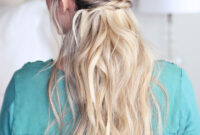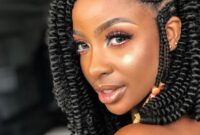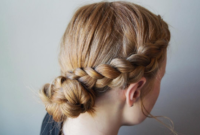Explore the enchanting world of Ethiopian hairstyle braids that reflect a rich cultural heritage while staying in vogue. Discover the techniques, history, and care tips for these stunning braids.
Ethiopian Hairstyle Braids: A Journey Through Culture and Style
Ethiopian hairstyle braids are more than just a fashion statement; they are a symbol of cultural heritage, identity, and personal expression. In this comprehensive guide, we’ll embark on a fascinating journey through the world of Ethiopian hairstyle braids. From their historical significance to the intricate techniques and styling tips, we’ll delve into every aspect, ensuring that you have all the knowledge you need to embrace this beautiful tradition.
The Allure of Ethiopian Hairstyle Braids
The enchanting world of Ethiopian hairstyle braids has gained popularity across the globe. Let’s explore what makes these braids so special and why they continue to captivate hearts and heads.
Ethiopian hairstyle braids are a fusion of artistry, culture, and self-expression. Rooted in the rich Ethiopian heritage, these braids showcase intricate patterns and designs that tell stories of tradition and pride. From weddings to daily life, these braids are a symbol of grace and elegance.
The History Behind Ethiopian Hairstyle Braids
Understanding the historical significance of Ethiopian hairstyle braids is essential to appreciate their beauty fully. The roots of these braids run deep, tracing back to ancient times.
Ethiopia boasts a history that spans thousands of years, and its people have always had a strong connection with their hair. Braids have been a symbol of social status, marital status, and even religious beliefs. Women would adorn themselves with elaborate braids to signify various life events and milestones.
Types of Ethiopian Hairstyle Braids
Ethiopian hairstyle braids come in various styles and designs, each with its unique beauty and symbolism. Let’s explore some of the most popular types.
1. Gondar Braids
Gondar braids are characterized by their intricate and tight weaving. They are often adorned with beads, cowrie shells, or colored threads, making them a work of art. Gondar braids are popular during special occasions and festivals.
2. Shuruba Braids
Shuruba braids are known for their stunning and elaborate patterns. These braids are often created for brides, signifying their transition into married life. They are adorned with jewelry and sometimes feature a headdress.
3. Harar Braids
Harar braids are simple, elegant, and have a unique texture. They are often worn by young girls and can be adorned with colorful beads. These braids are easy to maintain and have a timeless charm.
4. Dorze Braids
Dorze braids are unique because they are twisted and coiled into a bun-like shape on top of the head. This style is often adorned with beads and accessories, making it a popular choice for special occasions.

5. Habesha Braids
Habesha braids are intricate and smaller braids that are woven close to the scalp. This style requires skill and patience and is often worn as a protective hairstyle.

6. Albaso Braids
Albaso braids have characteristics thick, twisted, and coiled braids that are usually worn close to the scalp. The braids are created by sectioning the hair into parts and then twisting and coiling each section to form a tight, neat braid. Albaso braids can vary in size and length, and they are often adorned with beads, shells, or other decorative elements for a more intricate look.
7. Bunna Braids
Bunna braids are small, tight braids that are woven closely to the scalp. These braids are usually short to medium in length and can be worn in different patterns and shapes.

8. Sidamo Braids
Sidamo braids are thick, chunky braids that are sometimes divided into sections and decorated with beads or shells. This style is often worn down or pulled back into a ponytail.
9. Desta Braids
Desta braids are long, thin, and tightly braided extensions often adorned with beads or cowrie shells. This style is popular among Ethiopian women and is usually worn down or pulled back into a ponytail.
Techniques and Tips for Creating Ethiopian Hairstyle Braids
Creating Ethiopian hairstyle braids is an art form that requires skill and patience. Here are some techniques and tips to help you get started.
Materials Needed
To create authentic Ethiopian hairstyle braids, you’ll need the following materials:
- Ethiopian cotton thread
- Beeswax
- Comb
- Hair extensions (optional)
- Beads and cowrie shells for adornment
Preparation
- Sectioning: Start by parting the hair into neat sections. This is crucial for achieving symmetrical and well-balanced braids.
- Conditioning: Ensure the hair is clean, well-conditioned, and free of tangles. Applying beeswax can help with grip and manageability.
- Thread Preparation: Thread your cotton thread with a needle and cut it into equal lengths for each braid.
Braiding Technique
- Start Small: Begin with a small section of hair at the root. If you’re using extensions, incorporate them seamlessly into the braid.
- Incorporate the Thread: As you braid, include the cotton thread by weaving it along with the hair. This gives the braid its unique texture and appearance.
- Tight and Neat: Keep the braid tight and neat as you work your way down. Maintain even tension to ensure uniform braids.
Finishing Touches
- Adornment: Once you’ve reached the end of the braid, you can adorn it with beads, cowrie shells, or any other decorative elements that resonate with you.
- Sealing: Seal the ends of the braids with beeswax to prevent unraveling and ensure longevity.
Maintenance
- Avoid excessive moisture as it can cause the thread to weaken.
- Re-tighten or re-braid as needed to maintain a fresh look.
- Protect your braids at night by using a silk or satin bonnet.
Caring for Ethiopian Hairstyle Braids
Maintaining the beauty and longevity of your Ethiopian hairstyle braids requires proper care and attention.
Washing
- Use a mild sulfate-free shampoo and warm water.
- Gently massage the scalp to remove dirt and product buildup.
- Rinse thoroughly, ensuring no shampoo residue is left.
Conditioning
- Apply a lightweight, leave-in conditioner to keep the hair moisturized.
- Use a cotton swab to reach the roots and prevent dryness.
Drying
- Pat the braids with a towel to remove excess water.
- Allow the braids to air dry to prevent frizz.
Styling
- Experiment with different updos, buns, or accessories to change your look.
- Avoid excessive tension or weight on the braids to prevent breakage.
FAQs
How long do Ethiopian braids typically last?
Ethiopian hairstyle braids can last anywhere from 6 to 8 weeks, depending on the care and maintenance. Regular re-tightening may be needed.
Can anyone wear Ethiopian braids?
Yes, Ethiopian hairstyle braids are not limited to any specific ethnicity. They can be worn by anyone who appreciates the artistry and culture behind them.
Are there any specific cultural or religious guidelines for wearing these braids?
While Ethiopian hairstyle braids hold cultural significance, they are not limited to a particular religious or cultural group. Anyone can wear them, respecting their cultural roots.
Can Ethiopian braids be customized with different colors or beads?
Absolutely! You can personalize your braids with different colors of thread, beads, or cowrie shells to reflect your unique style.
Are Ethiopian braids suitable for different occasions?
Yes, Ethiopian hairstyle braids are versatile and can be worn on various occasions, from casual outings to special events like weddings and festivals.
How can I find a skilled hairstylist experienced in creating Ethiopian braids?
To find a skilled hairstylist, ask for recommendations within your local community or search online for hairstylists with experience in African braiding techniques.
Embrace the Timeless Beauty of Ethiopian Hairstyle Braids
In the tapestry of global hairstyles, Ethiopian braids stand out as a symbol of tradition, artistry, and cultural pride. Beyond their visual allure, these braids tell a story—a story of heritage, creativity, and the enduring spirit of Ethiopian communities. Whether you’re seeking a new hairstyle or exploring diverse cultural traditions, embracing Ethiopian hairstyle braids is an opportunity to connect with a rich legacy of beauty and elegance.
As you embark on this braiding journey, remember the essence of Ethiopian braids: they are not just strands of hair intricately woven; they are threads of culture, weaving together past, present, and future in a tapestry of timeless elegance. So, indulge in the beauty of Ethiopian hairstyle braids, and let your hair become a canvas for this exquisite art form, celebrating tradition, creativity, and the enduring legacy of Ethiopian culture.
Note: For further exploration of Ethiopian culture and traditions, visit Ethiopian Heritage Society.



